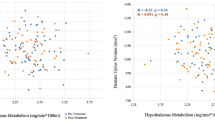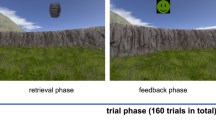Abstract
In depressed patients as well as healthy controls, a positive relationship between hippocampal volume and trait anxiety has been reported. This study sought to explore the possible inter-relation between hippocampal volume and trait anxiety further. Magnetic resonance imaging at 7 T was used to measure hippocampal volumes in a rat model of extremes in trait anxiety (experiment 1) and in a Wistar population with normal anxiety-related behavior (experiment 2). In addition to anxiety-related behavior, potentially confounding factors (depression-like, exploratory, and locomotor behavior) were assessed. Experiment 1 globally supported the hypothesis of a positive relationship between hippocampus volume and trait anxiety but did not allow for ruling out possible confounds arising from cosegregation of other behavioral traits. Experiment 2 yielded strong evidence for a negative relationship which was specific for trait anxiety. Thus, the relationship between hippocampal volume and anxiety may be more complex than expected. Interestingly, anxiety-related behavior in experiment 2 had a stronger influence on hippocampal volume than depression-like behavior. In the light of hippocampal volume loss in anxiety disorder and frequent comorbidity of anxiety and depression, this finding suggests that further research into the relationship between anxiety and hippocampal volume may be critical for understanding hippocampal contributions to normal and pathological behavior.
Similar content being viewed by others
Log in or create a free account to read this content
Gain free access to this article, as well as selected content from this journal and more on nature.com
or
References
American Psychiatric Association (2000). Diagnostic and Statistic Manual of Mental Disorders (DSM-IV-TR), 4th edn. APA: Washington, DC.
Beck AT, Epstein N, Brown G, Steer RA (1988). An Inventory for Measuring Clinical Anxiety: Psychometric Properties. J Consult Clin Psychol 56: 893–897.
Bremner JD, Randall P, Scott TM, Bronen RA, Seibyl JP, Southwick SM et al (1995). MRI-based measurement of hippocampal volume in patients with combat-related posttraumatic stress disorder. Am J Psychiatry 152: 973–981.
Bremner JD, Randall P, Vermetten E, Staib L, Bronen RA, Mazure C et al (1997). Magnetic resonance imaging-based measurement of hippocampal volume in posttraumatic stress disorder related to childhood physical and sexual abuse—a preliminary report. Biol Psychiatry 41: 23–32.
Campbell S, Marriott M, Nahmias C, MacQueen GM (2004). Lower hippocampal volume in patients suffering from depression: a meta-analysis. Am J Psychiatry 161: 598–607.
Crusio WE, Schwegler H, Brust I, van Abeelen JH (1989). Genetic selection for novelty-induced rearing behavior in mice produces changes in hippocampal mossy fiber distributions. J Neurogen 5: 87–93.
De Bellis MD, Keshavan MS, Shifflett H, Iyengar S, Beers SR, Hall J et al (2002). Brain structures in pediatric maltreatment-related posttraumatic stress disorder: a sociodemogrpahically matched study. Biol Psychiatry 52: 1066–1078.
Fennema-Notestine C, Stein MB, Kennedy MC, Archibald SL, Jernigan TL (2002). Brain morphometry in female victims of intimate partner violence with and without posttraumatic stress disorder. Biol Psychiatry 51: 1089–1101.
Gilbertson MW, Shenton ME, Ciskewski A, Kasai K, Lasko NB, Orr SP et al (2002). Smaller hippocampal volume predicts pathologic vulnerability to psychological trauma. Nat Neurosci 5: 1242–1247.
Gray JA, McNaughton N (2000). The Neuropsychology of Anxiety, 2nd edn. Oxford University Press: Oxford.
Gurvits TV, Shenton ME, Hokama H, Ohta H, Lasko NB, Gilbertson MW et al (1996). Magnetic resonance imaging study of hippocampal volume in chronic, combat-related posttraumatic stress disorder. Biol Psychiatry 40: 1091–1099.
Hall CS (1934). Emotional behavior in the rat: I. Defecation and urination as measures of individual differences in emotionality. J Comp Psychol 18: 385–403.
Henderson ND, Turri MG, DeFries JC, Flint J (2004). QTL analysis of multiple behavioral measures of anxiety in mice. Behav Genet 34: 267–293.
Kalisch R, Elbel GK, Gossl C, Czisch M, Auer DP (2001). Blood pressure changes induced by arterial blood withdrawal influence BOLD signal in anesthesized rats at 7 Tesla: implications for pharmacologic MRI. Neuroimage 14: 891–898.
Keck ME, Welt T, Muller MB, Uhr M, Ohl F, Wigger A et al (2003). Reduction of hypothalamic vasopressinergic hyperdrive contributes to clinically relevant behavioral and neuroendocrine effects of chronic paroxetine treatment in a psychopathological rat model. Neuropsychopharmacology 28: 235–243.
Landgraf R, Wigger L (2002). High vs low anxiety-related behavior rats: an animal model of extremes in trait anxiety. Behav Gen 31: 371–382.
Landgraf R, Wigger A (2003). Born to be anxious: neuroendocrine and genetic correlates of trait anxiety in HAB rats. Stress 6: 111–119.
Landgraf R, Neumann ID (2004). Vasopressin and oxytocin release within the brain: a dynamic concept of multiple and variable modes of neuropeptide communication. Front Neuroendocrinol 25: 150–176.
Lindauer RJ, Vlieger EJ, Jalink M, Olff M, Carlier IV, Majoie CB et al (2004). Smaller hippocampal volume in Dutch police officers with posttraumatic stress disorder. Biol Psychiatry 56: 356–363.
Lyons DM, Yang C, Sawyer-Glover AM, Moseley ME, Schatzberg AF (2001). Early life stress and inherited variation in monkey hippocampal volumes. Arch Gen Psychiatry 58: 1145–1151.
MacQueen GM, Campbell S, McEwen BS, Macdonald K, Amano S, Joffe RT et al (2003). Course of illness, hippocampal function, and hippocampal volume in major depression. Proc Natl Acad Sci USA 100: 1387–1392.
Maguire EA, Gadian DG, Johnsrude IS, Good CD, Ashburner J, Frackowiak RS et al (2000). Navigation-related structural change in the hippocampi of taxi drivers. Proc Natl Acad Sci USA 97: 4398–4403.
McEwen BS (2000). Effects of adverse experiences for brain structure and function. Biol Psychiatry 48: 721–731.
Mechelli A, Crinion JT, Noppeney U, O’Doherty J, Ashburner J, Frackowiak RS et al (2004). Neurolinguistics: structural plasticity in the bilingual brain. Nature 431: 757.
Murgatroyd C, Wigger A, Frank E, Singewald N, Bunck M, Holsboer F et al (2004). Impaired repression at a vasopressin promoter polymorphism underlies overexpression of vasopressin in a rat model of trait anxiety. J Neurosci 24: 7762–7770.
Paxinos G, Watson C (1998). The Rat Brain in Stereotaxic Coordinates, 4th edn. Academic Press: San Diego.
Pellow S, Chopin P, File SE, Briley M (1985). Validation of open:closed arm entries in an elevated plus-maze as a measure of anxiety in the rat. J Neurosci Methods 14: 149–167.
Porsolt RD, Anton G, Blavet N, Jalfre M (1978). Behavioural despair in rats: a new model sensitive to antidepressant treatments. Eur J Pharmacol 47: 379–391.
Rasmusson AM, Vythilingam M, Morgan III CA (2003). The neuroendocrinology of posttraumatic stress disorder: new directions. CNS Spectr 8: 651–657.
Rusch BD, Abercrombie HC, Oakes TR, Schaefer SM, Davidson RJ (2001). Hippocampal morphometry in depressed patients and control subjects: relations to anxiety symptoms. Biol Psychiatry 50: 960–964.
Salome N, Salchner P, Viltart O, Sequeira H, Wigger A, Landgraf R et al (2004). Neurobiological correlates of high (HAB) versus low anxiety-related behavior (LAB): differential Fos expression in HAB and LAB rats. Biol Psychiatry 55: 715–723.
Stein MB, Koverola C, Hanna C, Torchia MG, McClarty B (1997). Hippocampal volume in women victimized by childhood sexual abuse. Psychol Med 27: 951–959.
Trullas R, Skolnick P (1993). Differences in fear motivated behaviors among inbred mouse strains. Psychopharmacology 111: 323–331.
Videbech P, Ravnkilde B (2004). Hippocampal volume and depression: a meta-analysis of MRI studies. Am J Psychiatry 161: 1957–1966.
Villarreal G, Hamilton DA, Petropoulos H, Driscoll I, Rowland LM, Griego JA et al (2002). Reduced hippocampal volume and total white matter volume in posttraumatic stress disorder. Biol Psychiatry 52: 119–125.
Weinberger DA (1990). The construct validity of repressive coping style. In: Singer JL (ed). Repression and Dissociation: Implications for Personality Theory, Psychopathology, and Health. Chicago University Press: Chicago.
Wigger A, Loerscher P, Weissenbacher P, Holsboer F, Landgraf R (2001). Cross-fostering and cross-breeding of HAB and LAB rats: A genetic rat model of anxiety. Behav Gen 31: 371–382.
Wigger A, Sánchez MM, Mathys KC, Ebner K, Liu D, Kresse A et al (2004). Alterations in central neuropeptide expression, release, and receptor binding in rats bred for high anxiety: critical role of vasopressin. Neuropsychopharmacology 29: 1–14.
Wolf OT, Dyakin V, Vadasz C, de Leon MJ, McEwen BS, Bulloch K (2002). Volumetric measurement of the hippocampus, the anterior cingulate cortex, and the retrosplenial granular cortex of the rat using structural MRI. Brain Res Brain Res Protoc 10: 41–46.
Acknowledgements
We thank A Yassouridis for help with statistics and Marina Zimbelmann for help with experiments. AW was supported by a grant from Deutsche Forschungsgemeinschaft (DFG).
Author information
Authors and Affiliations
Corresponding author
Rights and permissions
About this article
Cite this article
Kalisch, R., Schubert, M., Jacob, W. et al. Anxiety and Hippocampus Volume in the Rat. Neuropsychopharmacol 31, 925–932 (2006). https://doi.org/10.1038/sj.npp.1300910
Received:
Revised:
Accepted:
Published:
Issue date:
DOI: https://doi.org/10.1038/sj.npp.1300910
Keywords
This article is cited by
-
Cortical functional activity in patients with generalized anxiety disorder
BMC Psychiatry (2016)
-
Early hippocampal volume loss as a marker of eventual memory deficits caused by repeated stress
Scientific Reports (2016)
-
Adult Neurogenesis and Mental Illness
Neuropsychopharmacology (2015)
-
Temporal MRI characterization, neurobiochemical and neurobehavioral changes in a mouse repetitive concussive head injury model
Scientific Reports (2015)
-
Divergent Functional Effects of Sazetidine-A and Varenicline During Nicotine Withdrawal
Neuropsychopharmacology (2013)



